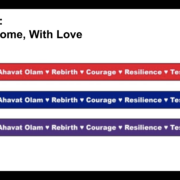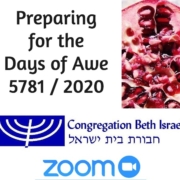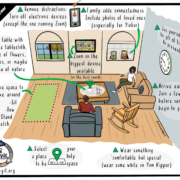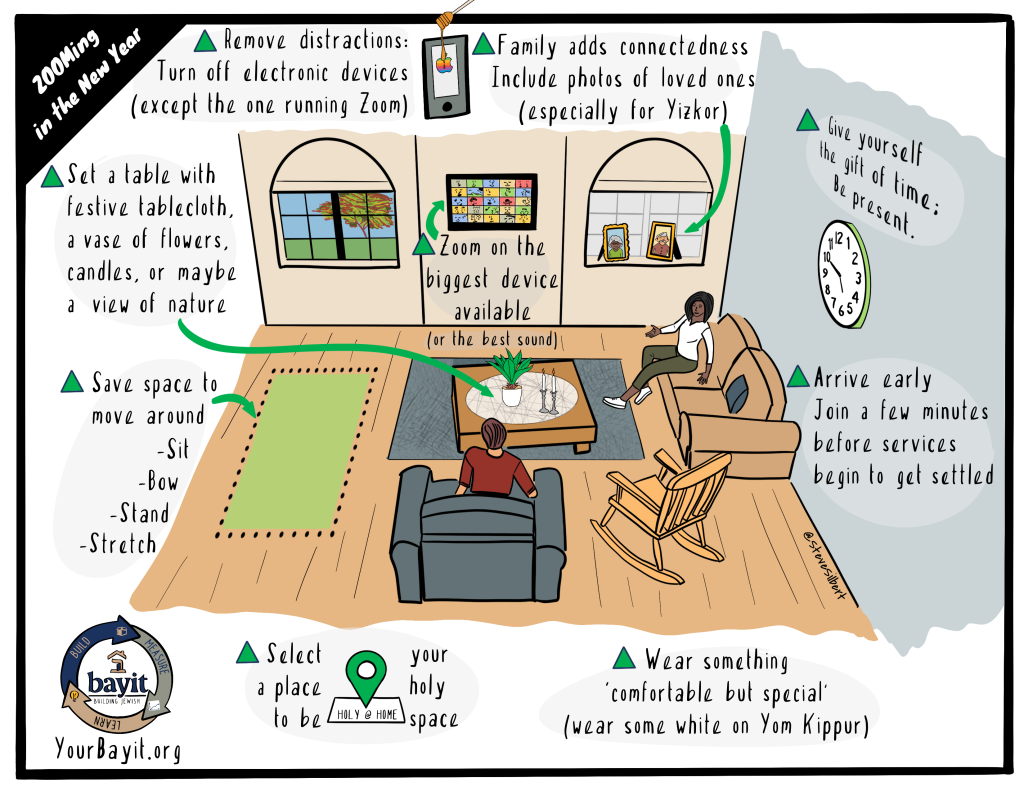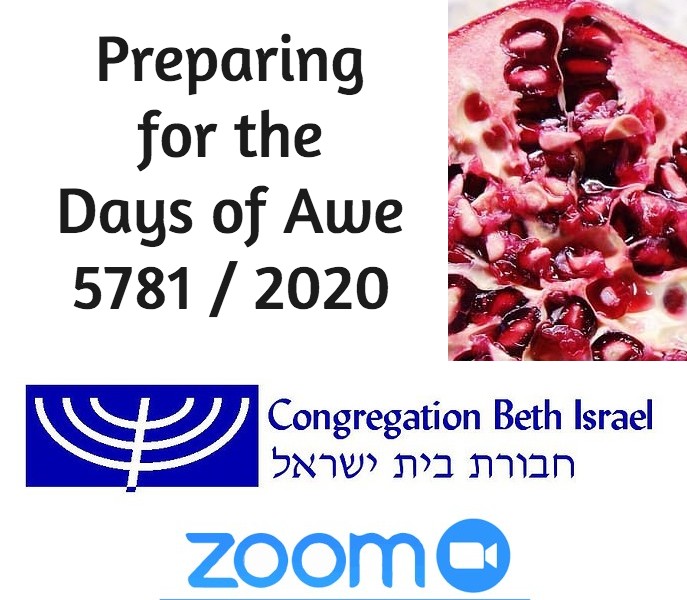[youtube https://www.youtube.com/watch?v=zNMuJWw6syY]
Here’s a video of my sermon if you’d rather watch it than listen to it. (It’s here on YouTube.) Or, you can read on, below…
Do you remember how you felt when you heard the news about the Pittsburgh synagogue shooting?
I remember feeling shock and horror and disbelief. I remember feeling grief. I remember our synagogue sanctuary filled with members of the Northern Berkshire community who came together for a vigil in grief and remembrance.
And I remember coming to shul the very next Shabbat — with a prickle of anxiety running through my veins — and stopping short when I saw the “graffiti love-in” all around our front door.
I knew it was coming. Someone I did not know had reached out to me earlier that week, saying that a group of non-Jewish allies wanted to organize a show of support for us. They didn’t want to surprise us in a way that would compound our feelings of un-safety, so they asked first.
But even though I knew they were doing something, I couldn’t picture what it would be. I didn’t know how it would feel to drive up to our shul one week after the Pittsburgh synagogue massacre and be greeted with chalk art and signs and cards and banners proclaiming that the North Adams community values us and wants us to be safe and wants us to be here.
Their gift made me weep tears of joy — because we are seen, and cherished, and uplifted. And not just by other Jews but by non-Jewish people, by people who are not part of our community or part of our covenant. But they saw that we were afraid, and they stood up for us and said, “you matter; we want you here; we’ve got your back.”
There’s a reason that the most oft-repeated commandment in Torah instructs us to love the stranger for we were strangers in the land of Egypt. Thirty-six times Torah tells us to love the stranger, the immigrant, the refugee, the vulnerable population, because we know how it feels to be in those shoes. The instruction is in the plural: v’ahavtem et ha-ger, y’all shall love the stranger. This isn’t an individual commandment: it’s a communal mitzvah. Together, we love the stranger because we know how it feels.
We know how it feels.
And that’s why I have two signs on my condo front door. One is a blue mogen David that says “Chai Y’all!” I want it to be clear to anyone who drives by that I am Jewish, I am here, I am visible, and I am welcoming! (And I say y’all.) The other is a sign that says Black Lives Matter.
I know that some Jews are uncomfortable with the Black Lives Matter movement because of real or perceived connections between BLM and pro-Palestinian sentiment. I empathize with that discomfort. And there are many intellectual conversations we can have about BLM and Israel / Palestine. But I believe that Jewish values call us to stand up for Black lives even if we feel some discomfort. We need to “de-center” ourselves, because right now this isn’t about us — it’s about standing up for the victims of prejudice and violence. And that’s work we do with our hearts and our souls, not just our intellect.
The Black Lives Matter movement is a grassroots coalition of many organizations, focused on saving the lives of Black people and people of color by changing how we do public safety and policing.
The vast majority of people protesting or holding vigils or putting signs on their lawns are not thinking about international issues (including the Middle East). They’re thinking about George Floyd who died gasping “I can’t breathe” to the officer kneeling on his neck. They’re thinking about Eric Garner who died gasping the same thing to the officer holding him in a chokehold. They’re thinking of Tamir Rice, killed at twelve because an officer mistook his toy for a gun. They’re thinking about Breonna Taylor and Ahmaud Arbery and Atiana Jefferson and Stephon Clark and Botham Jean and Philando Castile.
And maybe they’re thinking about the Greensboro Four, brutally beaten for daring to sit at a Woolworth’s lunch counter. Or Emmett Till, lynched because someone thought he smiled at a white woman. Or the countless Black souls ripped from home and brought to this nation in chains. Or the reality that Black people are dying of covid-19 at rates far higher than white people. Or 400 years of communal experience and communal trauma showing them just how little Black lives have mattered on these shores.
Just as we need non-Jewish allies to stand up for us when there are attacks on Jews, Black people in this country need allies to stand up for them when they are under attack.
And it’s not an either/or. There are many Black Jews who feel keenly both of these forms of oppression, both antisemitism and racism. Not in our little rural community, but in the broader Jewish community. We owe it to them to stand up for them…. and we need to stand up for non-Jewish Black lives, too.
Rabbi Margaret Frisch Klein, who serves as a police chaplain, expresses the needs of this moment with a policing metaphor from Sergeant Dan Rouse: “If we get a call about a domestic violence incident [at a particular address], we don’t stop at every other house along the way. If you go to a fundraiser for breast cancer, you don’t stop at every other fundraiser along the way and say all cancers matter. Right now, Black lives are hurting.” That’s the call we need to answer.
Remember how it felt to see those signs of support on our synagogue doors? I hope that’s how it feels for Black people to see a Black Lives Matter sign. It signifies that someone who sees their trauma and their fear is willing to stand up in the name of their safety. It means that someone who maybe doesn’t look like them nevertheless wants for them basic human rights and human dignity.
I mentioned earlier the discomfort that I know some of us feel around the connection between Black Lives Matter and support for the Palestinian cause. I honor the discomfort, and I understand it. And… I think our discomfort is part of our spiritual work in this time of American reckoning with institutionalized racism. I think part of our work as white-skinned Jews is saying: what you’re enduring is untenable and we stand with you against it, and any disagreements we might have about politics can wait.
We need to stand up for each other even when we feel discomfort. Safety and basic human dignity are the birthright of every human being, no matter what — or at least, they should be, and if they’re not, then we have work to do. And standing up for one another’s safety and dignity is a moral imperative more important than any political disagreement.
In her book Braving the Wilderness, social scientist Brene Brown notes that the English word courage is related to the French coeur: heart. Having courage means having heart. Having courage means listening to the heart and acting from the heart.
It takes courage to stand up for our fellow human beings when they are under threat. It takes courage to stand up and say: I will fight for your human rights and your dignity and your right to live safely. Even if your skin looks different from mine. Even if your politics are different from mine.
Standing up for Black lives is an act of hope that we can build a better America, an America where everyone truly enjoys the rights that our Declaration of Independence enumerates, among them life, liberty, and the pursuit of happiness. Of course, when that Declaration was written, the only people who merited those rights were white men! Thank God our laws no longer enshrine those injustices. But those injustices persist, and our work is not complete.
Standing up for Black lives asks us to confront our own stuff that might get in the way. It asks us to do our own inner work, and to learn how to be actively antiracist — to resist and change the subtle and pervasive racism that’s baked in to our nation’s history and its present. That kind of inner work is exactly what this season of teshuvah, repentance and return, is for.
Remember the kindness our non-Jewish North Adams neighbors extended to us after Pittsburgh? Standing up for Black lives is how we can “pay it forward.”
Torah asks us to love the stranger, because we were strangers in the land of Egypt and we know how it feels. We know how it feels! And we know how it feels when our neighbors stand up for us. May our knowledge move us to stand up for Black lives with hope and courage and heart.
For further reading: from the Jewish Council on Public Affairs, Black Lives Matter, American Jews, and Anti-Semitism: Distinguishing Between the Organization(s), the Movement, and the Ubiquitous Phrase [pdf] 2020.
This is Rabbi Rachel’s sermon from Rosh Hashanah morning (cross-posted to Velveteen Rabbi)


